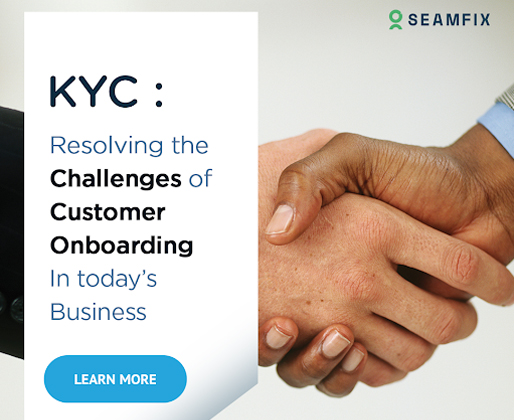Introduction
The global market is ever-evolving, thanks to the competition that exists among players in different industries. Each player, including banks and mobile operators, is faced with the business challenge of keeping existing customers and winning new ones. But then, this is the face value of the problem, that basically every business knows it should/will encounter. The real question lies in ‘how’? How do we keep the customers we have? How do we win new ones? And what is really being asked here is “How do we grow our business?”
In asking these questions, businesses like financial institutions and mobile operators have come to realize that the difference between the question and the answer lies with the customer. Hence, a global need for them to know, understand, and satisfy customers, the users of their services, through Client Onboarding. And this is something they must do, whether it is an integrated part of the business process or rising from a need to comply with KYC regulations.
However, the client onboarding process is not so easy as there are a couple of elements that challenge and contribute to its success. This article will address these challenges and aim to provide solutions for a seamless customer onboarding process.
The Challenges Of Customer Onboarding
Here are some of the challenges that a lot of businesses face in trying to implement KYC processes.
Quality of Data
In a study by Forrester Consulting, it was observed that the quality of data was one of the top three contributors to the challenges hampering the seamless onboarding of customers by businesses. Organizations often have their data existing in silos, so much that it is often difficult for them to process and sort certain records when they do not exist on one single platform. The unavailability of a central location for customer data, therefore, hardens this process of onboarding customers, especially in a world where everyone (customers in this case) pays attention to time spent on any activity.
Operational and Business Processes
In yet another global client onboarding survey by Forrester in 2014, it was reported that “over 64% percent of banks report lost deals and revenue due to problems in the current onboarding process with more than 20 percent of respondents indicating they’ve lost between 26 and 50 percent of new business opportunities as a result of issues during onboarding.”
It is now possible that this number has reduced with the advent of some organizations taking a more optimal approach to KYC onboarding. But we get the idea – that the rigid process of organizations can have a telling impact on customer onboarding. There is a need for businesses to move from approaching client onboarding as a mere routine and transcend to viewing it is an opportunity to grow the business.
Client/Customer Experience
The importance of customer satisfaction cannot be over-emphasized in today’s world, especially when customers have a sense that there are other options available to them. The flow of onboarding has to be seamless for customers – a thing that cannot be achieved with manual KYC processes.
Onboarding Time
In a survey by Thomson Reuters, it was observed that the time it took to onboard customers was on the rise. Financial institutions, as at 2015, were taking around 24 days to onboard new customers. It would increase by 18% in 2016. It is easy to imagine how much this would be frustrating for customers when they must take that long before they are finally onboarded. Not only would the business be losing customers, it would also be incurring more costs in onboarding operations, because of the increasing number of time it requires.
Non-adoption of Robust Digital KYC Solutions
This is a major problem for organizations, especially large ones. Most organizations aren’t making it easy for themselves when they don’t adopt a KYC solution for end-to-end customer onboarding. Mobile operators, for instance, need a robust IT KYC software that will facilitate Client Lifecycle Management, from when a new Customer purchases a new SIM and throughout their lifetime as a customer. It is worthy of note that automating the client onboarding process swallows a bulk of all the challenges that organizations face.
Best KYC Practices For Better Customer Onboarding
These are some of the practices that can be adopted in easing the customer onboarding process.
Establish/Update Business Policies
Client onboarding is a core part of the business function for businesses that have customers as their bottom line. In this case, it is important that together with the usual business activities, active management of the onboarding process is established, if any doesn’t exist already. For those who already have governance over Client Onboarding but find it hard to improve its KYC customer onboarding process, it’s also important to improve on existing policies regarding client onboarding and take forward decisions that will increase the bottom line.
Implementing A Robust KYC Solution
Client onboarding is easier with the help of a robust KYC solution that enables you to do everything in one place. This way, organizations don’t have to keep customer data in silos or collect it manually. It can also be accessed in real-time by anyone from the business who has access to the customer dashboard in the KYC solution. Furthermore, businesses for instance, with the help of robust and flexible digital KYC solutions like BioSmart & BioRegistra, do not only meet onboarding objectives, they also meet regulatory KYC requirements and make changes to the system as onboarding demands grow.
A Centralized KYC Team
Joe Dunphy, a director at Fenergo, in advocating for centralization says, “There should be a centralized customer onboarding process which involves a single set of know-your-customer specialists, a single client data repository, and a single set of high-level guidelines.” This team is then responsible for establishing a procedure for collecting customer details and monitoring their profiles, both old and new. This means they would also be tasked with ensuring that the KYC onboarding process is seamless for current customers and appealing for new ones.
Simplifying Customer Due Diligence
We have already established that automating customer onboarding will make the whole process easier for everyone involved. Verification of customer identity with ease using digital KYC solutions also contributes to the time for onboarding. It takes away repetitiveness and the need for customers to provide multiple physical documents as means of identification since it can be done through biometric methods like facial and fingerprint verification against what already exists.
Conclusion
Customer onboarding is one of the keys to the success of any customer-centric business and when not properly done or not at all, it could hurt the business. For one, regulatory bodies understand this and hence, why there have been regulations in certain industries like financial institutions and telecommunication firms to keep them in check and ensure that the process is as harmless as possible, to both the business and its customer. Implementing a robust KYC solution amongst others would do today’s businesses a whole world of good, partly also because customers are consciously looking for organizations that would make their lives (onboarding) easier.








